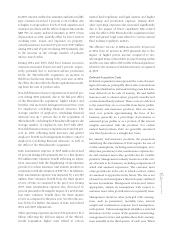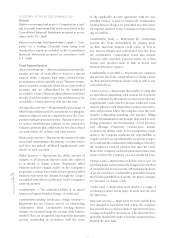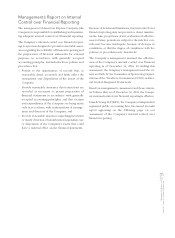American Express 2004 Annual Report Download - page 71
Download and view the complete annual report
Please find page 71 of the 2004 American Express annual report below. You can navigate through the pages in the report by either clicking on the pages listed below, or by using the keyword search tool below to find specific information within the annual report.
Interest-only strip — Interest-only strips are generated
from TRS securitization activity and are a form of
retained interest held by the Company in the securiti-
zation. This financial instrument represents the present
value of estimated future excess spread expected to be
generated by the securitized assets over the estimated
life of those assets. Excess spread is the net positive
cash flow from interest and fee collections allocated to
the third-party investors’ interests in the securitization
after deducting the interest paid on the investor
certificates, credit losses, contractual servicing fees and
other expenses.
Loss reserves as a percentage of loans — Represents the
amount of loss reserves expressed as a percentage of
the outstanding loan balance.
Loss reserves as a percentage of past due accounts —
Represents the reserve coverage of past due accounts.
Net card fees — Represents the card membership fees
earned during the period. These fees are recognized as
revenue over the card membership period (typically one
year) covered by the card fee, net of provision for pro-
jected refunds of card fees for cancellation of card mem-
bership. Similarly, deferred acquisition costs are amor-
tized into operating expenses over the card membership
period covered by the card fee.
Net interest yield — Represents the interest rate earned
on outstanding loan balances, net of related funding
costs.
Net loss ratio — Represents the ratio of write-offs, net
of recoveries on cardmember receivables expressed as
a percentage of the total charge card volume.
Net write-off rate — Represents the amount of loans
written-off, net of recoveries as a percentage of the
average loan balance during the period.
Network — Represents the Company’s global general
purpose charge and credit card merchant network.
Cards bearing the Company’s logo issued by TRS and
by qualified licensed institutions are accepted on this
network at merchant locations worldwide that accept
American Express branded cards.
Past due loans as a percentage of total loans —
Represents the percentage of loans that are 30 days
or more past due compared to the total amount of
loans outstanding.
Stored value and prepaid products — Include Travel-
ers Cheques and other prepaid products such as gift
cheques and cards as well as reloadable Travelers
Cheque cards. These products are sold as safe and con-
venient alternatives to currency and represent prepaid
financial instruments for the holders to use for purchas-
ing goods and services.
Travel sales — Represents the total dollar amount of
travel transaction volume for airline, hotel, car rental
and other travel arrangements made for clients under
travel management contracts. The Company earns rev-
enue on these transactions by charging a transaction or
management fee based on the contractual arrangement
with travel clients.
American Express Financial Advisors
Administered assets — Assets serviced by AEFA for its
clients, which include those held in customers’ broker-
age accounts. AEFA does not exercise management
discretion over these assets and does not earn a man-
agement fee. These assets are not reported in the
Company’s Consolidated Balance Sheet.
Assets managed for individuals — Assets that are ben-
eficially owned by customers substantially consisting
of those held in retail mutual funds. AEFA receives
management fees based on the value of the underlying
assets. These assets are not reported on the Company’s
Consolidated Balance Sheet. Also included in this cat-
egory are wrap account products provided to clients
for which AEFA earns fees based on the asset levels of
such accounts.
Assets managed for institutions — Consists of assets
within their defined contribution and defined benefit
plans as well as assets managed for corporations for
which AEFA earns management fees. These assets
are not reported on the Company’s Consolidated
Balance Sheet.
Cash sales — Represents the dollar volume generated
from the sales of mutual funds, annuities, investment
certificates, life and other insurance products, as well
as institutional and other related products. This volume
indicator captures gross new cash inflows which gen-
erate product revenue streams to AEFA. In the case of
mutual funds, transfers between funds of the same fam-
ily are generally excluded. In the case of life and other
insurance products, cash sales are generally defined as
the first year’s premiums.
Collateralized debt obligations — Represent securi-
tized interests in pools of assets that serve as collateral.
Multiple tranches of securities are issued offering inves-
tors various maturity and credit risk characteristics.
Scheduled payments to investors are based on the
AXP
AR.04
69
Financial Review
























